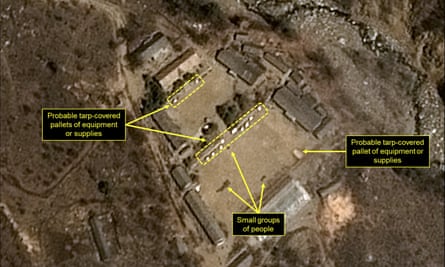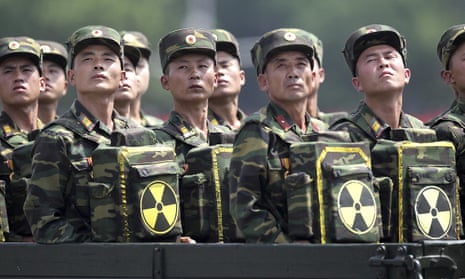North Korea is making preparations for a nuclear test in a show of defiance towards Donald Trump, who has not ruled out military action to pressure the regime into abandoning its nuclear weapons and ballistic missile programmes.
The US-based monitoring group 38 North said on Thursday that the satellite images from the North’s mountainous Punggye-ri site showed it was “primed and ready” for what would be the country’s sixth nuclear test since 2006.
“Commercial satellite imagery of North Korea’s Punggye-ri nuclear test site from April 12 shows continued activity around the North Portal, new activity in the main administrative area, and a few personnel around the site’s Command Center,” 38 North said on its website.
“In the courtyards of the main administrative area are approximately 11 probable tarp-covered pallets of equipment or supplies, a formation of personnel, and several individuals walking about,” the site added.
Melissa Hanham, a North Korea expert at the Middlebury Institute of International Studies at Monterey added that the satellite imagery also showed carts going in and out of a new tunnel, and that side of the mountain had been drained of water.
“I think its fair to believe from what we can see that all the conditions are such that they could have a nuclear test at any time,” Hanham said.
Some experts believe the regime is planning to conduct a missile launch or nuclear test to coincide with Saturday’s celebration of the day marking the birth of the country’s founder, Kim Il-sung, a hugely significant date in the North Korean calendar known locally as the Day of the Sun.
About 200 reporters, including those from Japan and the US, are currently in Pyongyang as the country prepares to mark the 105th anniversary.
South Korean officials were sceptical that a nuclear test was imminent this time. “There has been no unusual activity so far,” Roh Jae-chun, a spokesman for the country’s joint chiefs of staff, told reporters, according to Yonhap news agency.
Japan’s Nikkei business paper said on Thursday that the US had sent a “sniffer” plane to Japan to monitor any nuclear tests.
The aircraft, which has been used before to monitor North Korean rocket launches, has arrived on the southern Japanese island of Okinawa, the paper said, citing a Japanese self-defence force official.
Jon Wolfsthal, who was special assistant to Barack Obama on arms control and nonproliferation, cautioned that the apparent preparations did not guarantee a test would take place. North Korea knows it is being watched from above and has become adept at sending signals and hidingits intentions.
“We’ve known that North Korea could conduct a nuclear test at any time for months,” Wolfsthal said. “They have got quite good at hiding preparation signs from US intelligence but also displaying signs when they want to suggest either an escalation of tension or a demonstration of new capacity.”
“So its highly possible they may try to conduct a test on the anniversary but there is no guarantee or requirement that they do so. They can do it this week, next week, next month, and the question is what is the President Trump and the administration trying to do to reverse their progress.”
Over recent months, Trump has send a series of bellicose messages on North Korea, threatening some kind of unilateral action.
The USS Carl Vinson and its strike group are currently sailing north from Singapore, and are reportedly planning to conduct drills with Japanese self-defence force vessels en route to the waters off the Korean peninsula.
“We are sending an armada. Very powerful,” Trump said on Wednesday. “We have submarines. Very powerful. Far more powerful than the aircraft carrier.”
Experts and former officials said such a show of force might work in reassuring South Korea and Japan deterring provocative action by North Korea, but did not present a solution for dealing with Pyongyang’s rising nuclear and missile capabilities.
“There is no surgical strike, there is no magic silver cruise missile that can identify and destroy all of North Korea’s capabilities,” Wolfsthal said. “Any kind of military attack on North Korea essentially starts the second Korean war and the casualties will be enormous on both sides.”
Hanham said that as time goes on the crisis over how to deal with North Korea intensifies.
“I think they are coming to a very threatening point,” she said. “They have done enough nuclear tests that its not out of the realm of possibility they have a compact warhead that could fit on the tip of a missile ... In terms of their missile programme they have all the components of an ICBM just about tested.”
The Japanese prime minister, Shinzo Abe, on Thursday told a parliamentary panel North Korea may also be capable of firing missiles tipped with sarin nerve gas at the country.
A nuclear detonation would be the biggest test yet of Trump’s more aggressive stance towards North Korea, coming soon after he warned that the US was prepared to address North Korea’s nuclear threat without help from China, the North’s biggest ally and economic partner.

Earlier this week Trump tweeted: “North Korea is looking for trouble. If China decides to help, that would be great. If not, we will solve the problem without them! U.S.A.”
In a phone conversation with Trump on Wednesday, China’s president, Xi Jinping, repeated calls for a peaceful resolution to the nuclear issue.
“China remains committed to the goal of denuclearising the (Korean) peninsula, safeguarding peace and stability on the peninsula, and advocates resolving problems through peaceful means,” the Chinese state broadcaster CCTV quoted Xi as saying.
Trump said on Twitter that he and Xi had enjoyed a “very good” conversation about the “menace of North Korea”, and later praised China’s decision to send coal ships back to the North as part of UN sanctions against the regime.
The president said Xi had convinced him to rethink his earlier conviction that China could easily get North Korea to stop its nuclear and missile programmes.
“After listening for 10 minutes, I realised it’s not so easy,” Trump told the Wall Street Journal. “I felt pretty strongly that they had a tremendous power” over North Korea, he said. “But it’s not what you would think.”
An editorial in the Global Times, a tabloid linked to the Chinese communist party, warned that the recent US strike on a Syrian airfield lent greater weight to Trump’s warnings that Washington would respond to any North Korean provocation with or without Beijing’s help.
“The Korean peninsula has never been so close to a military clash since the North conducted its first nuclear test in 2006,” it said, adding that Pyongyang “should avoid making mistakes at this time”.
The China Daily, however, adopted a more cautious tone. “The truth is that although the prospect of war may seem real, no party really wants a war,” the newspaper said. “Many sources indicate Washington is increasing the pressure in the hope that Pyongyang will change course without a shot being fired. Otherwise, it would not have insisted that Beijing could and should help rein in Pyongyang.”
The newspaper called on North Korea to refrain from conducting missile or nuclear tests at the weekend, and urged the US and South Korea to suspend joint military drills that Pyongyang regards as a dress rehearsal for an invasion.
Coupled with recent missile launches, a nuclear test could offer experts a better idea of how far North Korea is from being able to mount a miniaturised nuclear warhead on an intercontinental ballistic missile (ICBM).
On Thursday, Australia’s defence industry minister, Christopher Pyne, said North Korea was developing a nuclear-armed missile capable of reaching Australia and the United States “within two years”.
Pyne made the claim after the acting US ambassador to Australia, James Carouso, said in an interview with the Australian that there was “extreme concern” that North Korea would be able to strike the west coast of the US and Australia with nuclear missiles within that timeframe.
The source of Carouso’s claim wasn’t clear, but many experts believe it will take North Korea several years to perfect an ICBM capable of carrying a nuclear warhead.
Additional reporting by Tom Phillips in Beijing
